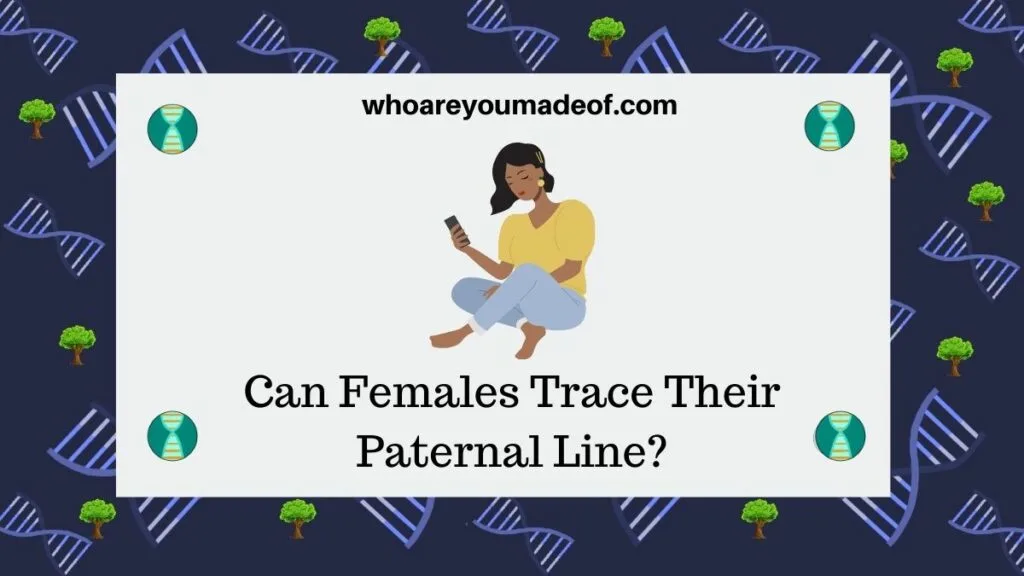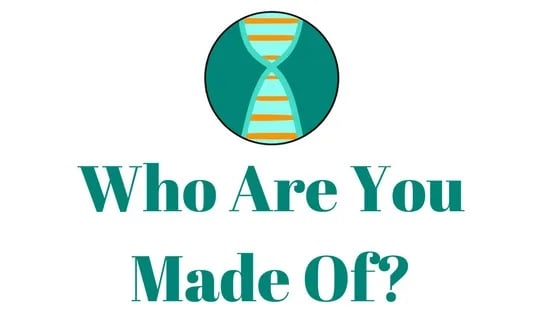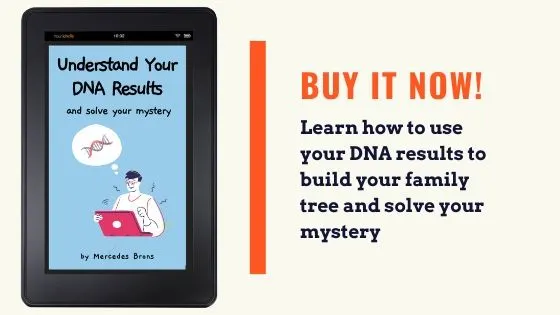Have you wondered if females can trace their paternal line? While women tracing their paternal line can encounter obstacles, females do have options for learning where their paternal ancestors came from.
In this article, you will discover:
- Whether a woman can trace her paternal DNA
- If a female’s DNA test results show both parents
- Can a female have a paternal haplogroup
- What type of DNA a female inherits from her father
- How a female can trace her paternal lineage

Through the process of exploring my family tree and learning about DNA testing, I have realized that females can learn an incredible amount about our paternal lineage, even if we do not have the Y-DNA chromosome.
The lack of Y-DNA chromosome is but a tiny obstacle in the way of female’s tracing their father’s lines.
Can a woman trace her father’s DNA?
Yes, a woman can trace her father’s DNA through various means. Through autosomal DNA tests or Y-DNA tests taken by herself, her father, brother, or paternal male cousins descended from their common grandfather through an uncle, and test results from other relatives, females can trace their father’s DNA.
People are often surprised to learn that even DNA results from female relatives on the paternal side of a family can help us learn about our father’s ancestors. For example, a paternal aunt taking an autosomal DNA test can reveal information about both of our paternal grandparents.
Before we go further into learning who could take a DNA test to help a female learn about her paternal ancestry, we need to learn a bit about exactly what shows up on DNA results for a biological female.
Does a female DNA test show both parents?
Yes, female DNA test results, such as those from AncestryDNA or 23andMe, will show information from both parents. This is because everyone inherits DNA from both of their parents, including females, which means that females can learn about both sides of their family through DNA testing.
There are specialized DNA tests that only test for mitochondrial (mtDNA) or Y-DNA. In this case, a mtDNA test for males and females would not show any paternal information.
Furthermore, females do not have Y-DNA, which means that this type of DNA test would not reveal information about the female’s paternal side of the family.
If you were under the impression that there is difference in the type of DNA passed down from parents to their children based on their biological gender, then you were correct. Both males and females inherit their mitochondrial DNA from their mothers, while only males inherit Y-DNA from their fathers.
What DNA does a female inherit from her father?
To make matters a bit more complicated, there is a third “type” of DNA that humans inherit from their parents, aside from 50% of each parent’s autosomal DNA. Females have two X chromosomes (compared to the X and Y chromosome in males), and one of those X chromosomes is passed down, completely intact, from their father.
This X-DNA is important, and we will talk more about it in the following sections.
To summarize, females inherit the following DNA from their parents:
- 50% of their autosomal DNA from their father
- 50% of their autosomal DNA from their mother
- A “recombined” X chromosome from their mother
- A full X chromosome from their father
- mtDNA from their mother
To explore the different types of DNA above, a female must be sure to choose the right type of DNA test. Not every DNA test will reveal information about all of the “types” of DNA that I mentioned.
Plus, you might have noticed that I did not mention a paternal haplogroup, or Y-DNA, on the list.
Can a female have a paternal haplogroup?
A female does not have technically have a paternal haplogroup. This is because females do not inherit Y-DNA from their fathers.
In fact, females do not even have a Y-DNA chromosome. One copy of this chromosome along with one copy of an X-chromosome is what males have.
Females, on the other hand, have only two copies of the X-chromosome. Even though females do inherit a copy of the X-chromosome from their fathers, the X-DNA is not assigned to haplogroups.
The X-chromosome changes too quickly between generations to make something like a haplogroup useful, so instead we do X-DNA matching, something very different from the concept of haplogroups.
This means that females do not technically have paternal haplogroups. (They do, however, have mitochondrial DNA haplogroups!)
Just because a female does not have an actual paternal haplogroup doesn’t mean that she is out of luck. Women and biological females can also trace their paternal lines, just like males can.
How can a female trace her paternal line?
There are many ways that women can trace their paternal ancestry. In fact, using the strategies below, a female can learn anything about her family tree and paternal DNA that a male could.
There really are no limits or differences between what males and females can learn about their ancestors, especially when we think outside the box a little when it comes to DNA testing.
A female can learn about her paternal line from her own DNA
As you learned in the previous sections of this post, females do inherit autosomal and X-DNA from their fathers. An autosomal DNA test, such as the ones offered by 23andMe, My Heritage DNA, Family Tree DNA, and Ancestry DNA, can offer extensive information about a female’s paternal lines of the family.
50% of a female’s autosomal DNA comes from her father. In addition, this autosomal DNA was passed to the daughter through both of the father’s parents.
This means that the daughter’s DNA results will show information from both of the paternal grandparents’ lines of the family tree, which is an advantage over the other types of DNA tests. For example, Y-DNA and mtDNA tests only show details about an estimated 2% of our ancestry.
Female autosomal DNA results will include:
- An ethnicity estimate or ancestry estimate that explains where her ancestors likely lived over the past few hundred years
- An extensive list of DNA relatives, also called DNA matches
The most useful aspect of DNA results are DNA matches. Identifying how we are related to a DNA match can help us identify new ancestors and learn more about our family tree.
Other relatives can take a DNA test to help a female learn about her paternal ancestry
Asking other relatives to take a DNA test is another great way for a female to trace her paternal line. The obvious first choice is to ask our fathers to take a Y-DNA test to reveal his paternal haplogroup, and an autosomal DNA test to see what DNA we didn’t inherit from him might reveal.
For many females, however, it is not possible to have their father take a test. Even in this situation, a female often has several options for asking additional relatives to take a test to learn more about the paternal side of her family.
For example:
- If a female has a brother with whom she shares the same father, a Y-DNA test can reveal her father’s Y-DNA haplogroup
- A paternal half-sibling or full-sibling’s autosomal DNA results will reveal ethnicity regions and/or DNA matches from the autosomal DNA that the female did not inherit from their shared father (since even full siblings don’t share 100% of their DNA with each other)
In addition, if older generations of relatives are available and willing to take a DNA test, this is especially valuable. For example, grandparents have DNA that they didn’t pass down to our parents, meaning that paternal grandparents can provide access to DNA information that our father did not inherit.
Sometimes, even great-uncles or aunts are available and willing to take DNA tests to help us explore our family tree.
If a female is very interested in learning about what her father’s Y-DNA haplogroup was, but she has no brothers or uncles available to take a Y-DNA test, she could consider asking male first or second cousins who are descended from her direct-line male ancestor through his male descendants.
For example, a first cousin descended from your paternal grandfather through one of his sons will share the same Y-DNA haplogroup as your father.
As an alternative, a second cousin descended from your paternal great-grandfather (your paternal grandfather’s father) as one of his son’s son’s sons, will share the same haplogroup as your father. Some people have even had good luck inquiring about haplogroups from third cousins, but since we may not know our third cousins, this may be a bit more difficult.
Building a family tree is the third way that a female can trace her paternal lineage
As a third option, females can always go the “traditional” route of building a family tree to research her paternal lines. This is an option that is always available, as long as the identity of the father is known.
To learn more about the basics of building a family tree, this post is helpful: Beginner’s Guide to Building a Family Tree
Even if the exact identity of the father is unknown, a female’s autosomal DNA results can often reveal sufficient information about who her paternal grandparents and great-grandparents were for her to begin building a family tree. Read: Strategies for Finding Unknown Grandparent Using DNA
Once the grandparents have been identified, great-grandparents and great-great grandparents can often be confirmed through DNA matching with relatives from those lines of the family tree. If a full or half brother sharing the same father is available for DNA testing, Y-DNA results can sometimes confirm a surname (through Y-DNA matches) and of course, provide a paternal haplogroup.
Conclusion
I hope that this post has helped you understand more about what females can learn about their paternal lineage, both through DNA testing and traditional genealogy research. As you now know, even though females do not have a Y-chromosome, there are still ways that we can trace our father’s direct-line.
If you have any questions about something that you have read in this post, or if you would like to share something interesting that you have learned about your paternal lineage, please join us in the discussion below.
Thanks for stopping by today!


Rachel Morris
Sunday 27th of August 2023
Hi Mercedes,
Thank you! This is so helpful! I don't know of living male relatives. But I see I can trace my dad's side through the second X chromosome passed down through him! That totally makes sense! Because I showed up with tons of physical and personality traits from BOTH my parents, so it only makes sense that I could find out more about my ancestry that way. Thank you for the explanation, as well as other avenues to look.
In Gratitude, Rachel
Ancestree Gal
Saturday 17th of June 2023
Great article! 👏🏻
I'm wondering if a female could trace her PATERNAL GRANDMOTHER'S line with any sort of test currently on the market? My dad's mom is where the interesting stuff lies but the mtDNA only traces a girls' mom's side while yDNA = dad's dad's dad. It looks like both sexes are out of luck if they want to know more about their dad's mom's line (or mom's dad's line for that matter)?
Or maybe I'm just a slow learner. Quite possible. Thanks!
Megan Aileen Quinn
Thursday 18th of May 2023
So I do know my father's Y-DNA haplogroup because a first cousin has taken a test with 23 and me. We haven't been able to pinpoint exactly where in Ireland my great grandfather was born. Now that I know my dad's Y-DNA haplogroup will I be able to maybe figure this out?
Robbin
Thursday 7th of July 2022
Hello I was told the day before I thought that was my grandmother died that her son wasn't my real father. My mother won't answer and there is no men in my family left. Should I purchase 23&me to find out? Thanks robbin
Gaylene
Thursday 25th of November 2021
I am the only child (female) of my father, he is deceased, his father was not listed on his birth certificate . I have found DNA matches to his mother my grandmother ……. Will I ever be able to trace my grandfather ? I have one child a male, would it be of any use if I had him take a DNA test, or would it just trace back on my husbands paternal side?